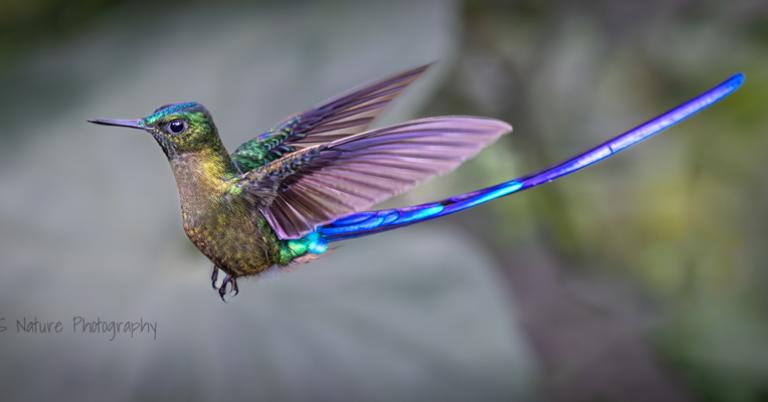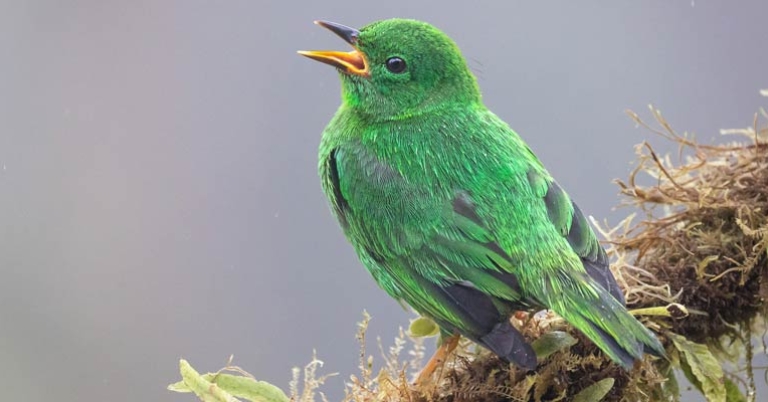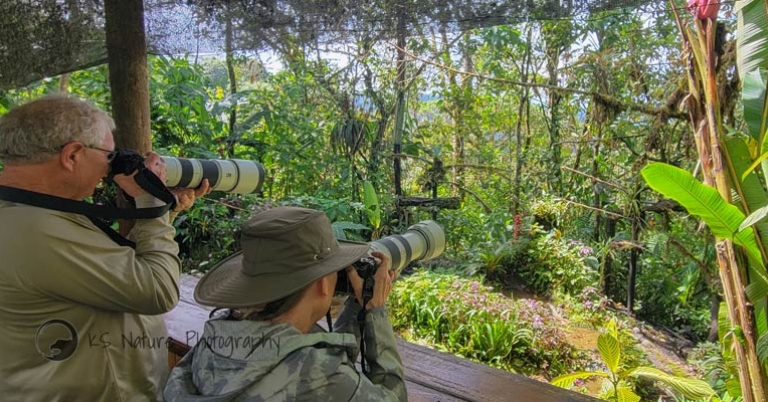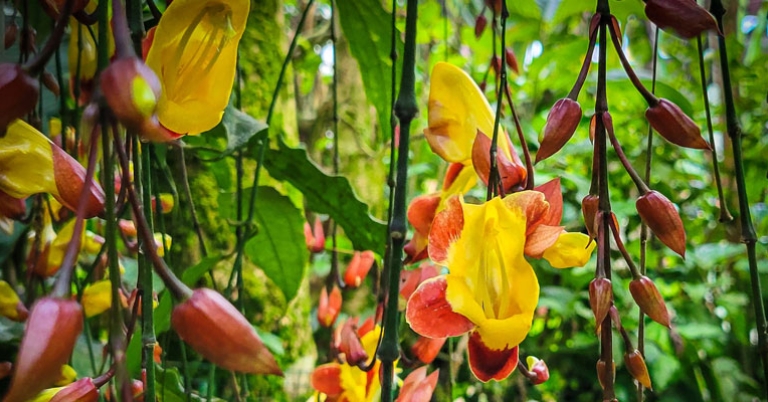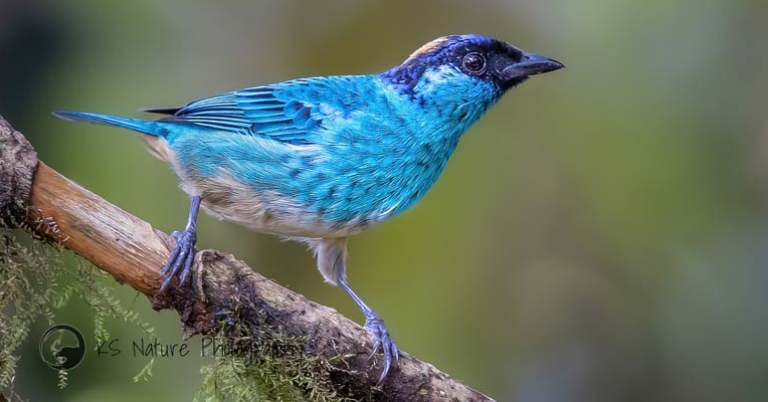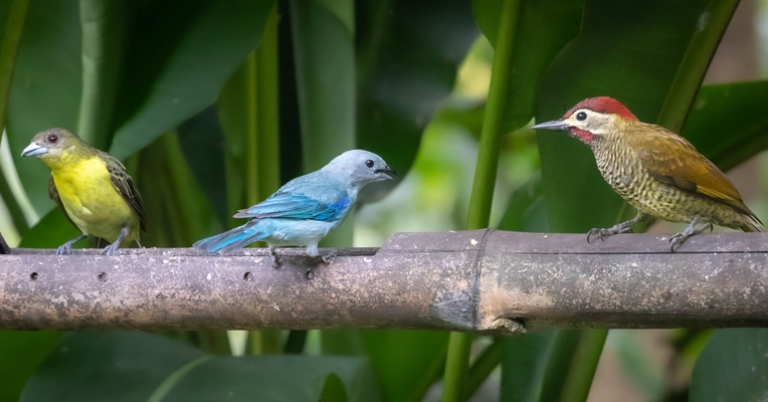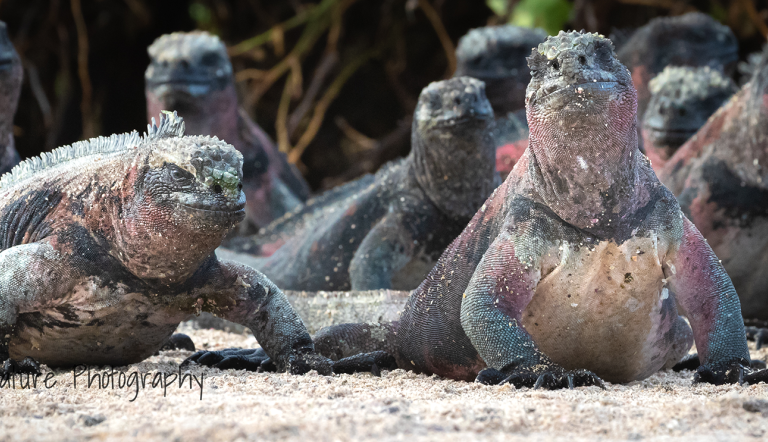Ecuador | Birding and Photography in the Chocó-Andes
About this trip
 Enjoy excellent photography opportunities on an unforgettable 7-day journey with KS Nature Photography. Accompanied by award-winning photographer Krisztina Scheeff, you'll observe and photograph the extraordinary abundance of bird life that inhabits the cloud forests of the Ecuadorian Andes; many of the avian species you'll encounter are endemic to the Chocó ecoregion, while others are more easily found here than anywhere else. You'll also add other subjects like colorful butterflies, amphibians, and flora to your portfolio, while meeting with community members and learning about area conservation projects.
Enjoy excellent photography opportunities on an unforgettable 7-day journey with KS Nature Photography. Accompanied by award-winning photographer Krisztina Scheeff, you'll observe and photograph the extraordinary abundance of bird life that inhabits the cloud forests of the Ecuadorian Andes; many of the avian species you'll encounter are endemic to the Chocó ecoregion, while others are more easily found here than anywhere else. You'll also add other subjects like colorful butterflies, amphibians, and flora to your portfolio, while meeting with community members and learning about area conservation projects.
Highlights
- Seek out and photograph the birds of the Chocó ecoregion in a variety of protected areas, including Yanacocha Biological Reserve, Alambi Cloud Forest Reserve, Bellavista Cloud Forest Reserve, and others.
- Visit the famed Refugio Paz de las Aves, known as a haven for antpittas and Andean Cocks-of-the-rock and an excellent example of community conservation.
- Capture images of dozens of hummingbird species; possibilites include the Sword-billed Hummingbird, Giant Hummingbird, and the endemic Black-breasted Puffleg.
- Bird the Mashpi-Amagusa Reserve for target species like the Rose-faced Parrot, Orange-breasted Fruiteater, Chocó Vireo, Moss-backed Tanager, and Indigo Flowerpiercer.
- Spend a full day birding and photographing along the trails in Antisana Ecological Reserve, whose varied ecological zones range from páramo to lowland rainforest.
Meet your leader
 Krisztina Scheeff, KS Nature Photography
Krisztina Scheeff, KS Nature Photography
Based in San Diego, CA, Krisztina Scheeff is an award-winning and professional nature photographer. Recognized for her photographic work in National Audubon Society as well as a finalist in the prestigious Wildlife Photograph of the Year competition, Krisztina’s photos have been published in magazines and articles around the world, including National Geographic, Wild Planet Photo Magazine, California 101, San Diego Audubon Society, American Wild Magazine, Birders Digest, Marine Conservation Magazine – UK, North American Nature Photography Association, and more. They have also been featured in Art Shows and Galleries around the country. Krisztina operates a successful business leading Photography Workshops and Tours to Scotland (Puffins), Ireland, Galápagos Islands, Costa Rica, Ecuador, Hungary, and Bosque del Apache, NM. She also leads workshops for bird festivals around the country and presents at various events.
Krisztina spent years studying and photographing the Rushing Grebes and guides her clients at Lake Hodges in San Diego to experience this amazing behavior and capture their own photos.
To see more photos, check out KS Nature Photography at www.KSNaturePhotography.com, on Facebook at www.facebook.com/KSNaturePhotography or on Instagram @KSNaturePhotography.
$2,895
Per person
About this price
Land cost only. Does not include round-trip airfare to and from destination.
Single room supplement $375
What makes us different
Rich content
Carbon offsetting
Wildlife up-close
Service anytime
We know what photographers need
Top birding guides
Daily Itinerary
Print ItineraryPuembo
Puembo
Mindo
Mindo
Mindo
Puembo
Farewell
Pricing
Print Pricing$2,895
Per person
About this price
Land cost only. Does not include round-trip airfare to and from destination.
Single room supplement $375
What's Included
- Arrival and departure transfers based on individual flight schedules
- Full time expert birding naturalist guide for duration of program
- Activities and meals as mentioned in itinerary
- Private transportation and driver for the duration of the program
- All Tips except Guide and Driver
- Carbon Offset
What's Not Included
- International airfare
- Items of personal nature
- Tips for guide and driver
- Travel Insurance
Pricing Details
A deposit of $450 is required for participants to register and reserve space on the program. Reservations submitted beyond the final payment deadline noted below will require full payment to enroll. 120 or more days before departure: $250 cancellation fee; remaining balance is refunded. 119 - 96 days before departure: full deposit of $450 is forfeited. 95 - 0 days before departure: 100% of program price is forfeited.
Holbrook Travel strongly recommends the purchase of travel protection for medical emergencies while traveling and to protect your investment. Please note the purchase of Cancel for Any Reason Coverage or to exclude pre-existing conditions with Trip Cancellation coverage may require policy purchase within 10-14 days of your initial deposit, depending upon the provider.
Single room supplement $375
Final payment due date: August 29, 2026
Travel Info
Print Travel InfoEntry & Exit Requirements
U.S. citizens must have a valid passport to enter Ecuador. Passports must be valid for at least six months after the date of departure.
For visits fewer than 90 days, visas will be issued upon arrival in Ecuador. Tourists may be required to provide evidence of return or onwards travel.
If you are not traveling with a U.S. passport, please check with the Embassy of Ecuador for the requirements based on your nationality.
Health Information
IMMUNIZATIONS
The Centers for Disease Control recommends that all travelers be up to date on routine vaccinations such as measles-mumps-rubella (MMR) vaccine, diphtheria-pertussis-tetanus vaccine, varicella (chicken pox) vaccine, and your yearly flu shot before every trip.
There are no vaccinations required for entry into Ecuador (unless you have spent more than 10 days in Bolivia, Brazil, Colombia, or Peru immediately prior to arrival, or are arriving from the Democratic Republic of the Congo or Uganda, in which case proof of yellow fever vaccine is required; the vaccine must have been administered at least 10 days before arrival, and is valid for life).
Though vaccination is not required for most travelers, yellow fever is a risk in certain parts of Ecuador, primarily east of the Andes at elevations below 7,550 feet. In addition to protecting against mosquitos, the CDC recommends the yellow fever vaccine if you are traveling to these areas.
The CDC also recommends inoculation against hepatitis A, hepatitis B, and typhoid for most unvaccinated travelers to Ecuador.
Please consult your physician for additional information and recommendations based on your individual circumstances.
MALARIA
The CDC warns that malaria is a risk in certain parts of Ecuador, primarily at elevations below 5,000 feet. Malaria is caused by a parasite found in Anopheles mosquitos, which are active from dusk until dawn. In some areas of Ecuador (particularly in parts of the Ecuadorian Amazon), the CDC recommends the use of anti-malarial drugs combined with mosquito avoidance; in other regions, the CDC recommends mosquito avoidance only.
If you are visiting areas where malaria is present and choose to use an anti-malarial drug, as recommended by the CDC, see your doctor for a prescription.
To protect against mosquitos, the CDC recommends that you cover exposed skin with lightweight, long-sleeved shirts and pants, consider treating clothes with permethrin, and use an insect repellent containing an EPA-registered active ingredient like DEET, picaridin, or oil of lemon eucalyptus (OLE). Apply sunscreen first, followed by the repellent, ideally 20 minutes later.
Be careful when applying products containing DEET, as it can damage or dissolve certain synthetic fabrics as well as plastic, rubber, vinyl, or elastic materials, such as those used in camera equipment, binoculars, phone cases, sunglasses, or watches. Additionally, some research suggests that when DEET and picaridin enter local waterways, they can be harmful to amphibians and other wildlife. When selecting a repellent, it is ultimately up to each traveler to weigh the risks and benefits of different options, keeping in mind both environmental factors and the importance of protecting against illness.
Dengue Fever & other insect-borne illnesses
The CDC warns that dengue fever is a potential risk in Ecuador. In addition, locally transmitted cases of Zika virus and chikungunya have previously been reported. The CDC recommends that travelers to Ecuador protect themselves against mosquito bites.
As a precaution, the CDC advises women who are pregnant to consider postponing travel to any area where Zika virus transmission is ongoing.
ALTITUDE SICKNESS
Upon arrival at locations of high elevation, shortness of breath and a pounding heart are normal responses to the lack of oxygen in the air. However, for some visitors, these symptoms can deteriorate into altitude sickness. Headache, extreme tiredness, dizziness, nausea, and loss of appetite are standard symptoms. Staying hydrated and well rested is important to adjust to the altitude. Avoiding heavy, fatty foods and alcohol in the days before arriving to altitude can help. Over-the-counter medications are also available to help prevent or alleviate symptoms. It’s advisable to avoid sleep medications, as they can slow breathing and respiration, which aid in getting the blood oxygenated while sleeping. Participants who take blood pressure medications should discuss this with their doctor as the medication can drop pressure too low at times.
SUN EXPOSURE
The effects of the sun can be damaging to the eyes and skin. Spending time outdoors exposes you to the sun’s harmful ultraviolet (UV) rays, even on cloudy days. To protect yourself from the sun, use a broad spectrum sunscreen of at least SPF 15, protect skin with clothing, wear a wide-brimmed hat and sunglasses, and drink plenty of fluids.
Respiratory Illness Protocols
Please review our Respiratory Illness Protocols page, which explains our policy and procedures if you or another traveler should develop symptoms of a respiratory illness during your trip. Your participation in a Holbrook Travel program indicates that you are in agreement with these protocols.
Resources
Print ResourcesPacking Recommendations
Everyone has personal preferences when it comes to packing; for this reason, the information below is offered as a general guide and not a definitive list. You know yourself best: Use your discretion and pack what you think will serve you, based on your personal preferences and specific itinerary.
You may find many of the items below in our Gear Store.
CLOTHING
Bring enough clothing suitable for the length of your program. If you prefer to pack light, note that many hotels offer laundry services at additional cost. If you plan to hand-wash items, remember that humidity may delay drying time.
Pack clothing that can be worn in layers to adapt to weather changes throughout the day. If your program includes visits to higher elevations, warm clothing is strongly recommended. Temperatures can get quite chilly, especially at night and early in the morning, and hotel rooms don’t always have heat. It can also be windy at times. Consider packing a warm underlayer, as well as a warm, protective outer layer.
- A combination of short-sleeved and long-sleeved shirts
- Shorts
- Lightweight, quick-drying long pants for sun and mosquito protection; jeans tend to be uncomfortable in hot and humid conditions, but are fine in the cooler highlands.
- Undergarments
- Sleepwear
- Lightweight jacket or sweater/sweatshirt (or heavier weight if visiting high-elevation areas)
- 1-2 bathing suit(s) for the beach or hot springs, if applicable, plus many hotels have pools
- Socks – Bring extra pairs. If your itinerary indicates muddy hikes with rubber boots provided on-site, pack a few pairs of knee socks to prevent blisters.
- Shoes – Consider your specific itinerary when choosing footwear. For most programs, you’ll likely want at least one pair of comfortable, closed-toe walking or hiking shoes suitable for forest hikes and walking over cobblestones or other uneven terrain. Sturdier hiking boots may be appropriate for more rugged itineraries. In addition, many participants opt for a pair of sturdy sport-strap sandals (e.g. Keens, Tevas, or similar) and/or casual flip-flops or sandals. If you’re visiting the beach, you may also want a pair of aqua socks, reef walkers, or water shoes.
- Lightweight rain jacket, hooded poncho, and/or windbreaker
- Visor or wide-brimmed sun hat; wool hat or beanie for higher elevations
- Bandana, scarf, or neck gaiter
Personal Toiletries
Pack toiletries based on your personal preferences and habits. Below are just a few recommendations to keep in mind.
- Shampoo, conditioner, lotion, deodorant/antiperspirant , etc. – If possible, avoid strong fragrances if you are sensitive to insect bites and in consideration of your fellow travelers.
- Soap and washcloth or a small, quick-drying microfiber towel – Washcloths are not standard in all hotels. If you normally use a washcloth, you may wish to bring one from home.
- Hairbrush, comb, hair ties, shower cap. Not all hotel rooms provide a hair dryer, so you may wish to bring one from home.
- Toothbrush and toothpaste
- Razor
- Ear plugs, especially if you are a light sleeper
- Personal hygiene products
- Insect repellent
- Sunscreen and lip balm with SPF – If you’ll be in the ocean, we recommend reef-safe sunscreen.
- Aloe vera gel
- A travel pack of tissues – also useful as napkins or toilet paper if needed
In addition to your personal toiletries, it is useful to pack a small medical kit, which you can easily prepare. Helpful items might include: bandages, antihistamine, a pain reliever, motion sickness and/or altitude sickness medication (if you are prone to either), anti-diarrhea medicine, individually wrapped pre-moistened towelettes and/or hand sanitizer, antibiotic ointment, anti-fungal cream, moleskin for blisters, eye drops, tweezers, a mini sewing kit, and an extra pair of disposable contact lenses or eyeglasses if you wear them.
Miscellaneous
Remember to pack valuables such as your passport, cash/credit cards, and medications in your carry-on luggage.
- Passport and photocopies of all travel documentation
- Personal insurance card and travel insurance information
- Money – ATM/credit card, and/or cash; small bills in good condition are recommended
- Prescription medicines (if applicable), with a copy of the prescription
- Yellow fever certificate (if required; only if arriving from Brazil, Democratic Republic of the Congo, or Uganda)
- Sunglasses with strap
- Small day pack for hikes and excursions
- Flashlight and/or head lamp
- Travel alarm clock or inexpensive waterproof wristwatch with alarm – Not all hotels provide alarm clocks.
- A pocket calculator or phone to assist with conversions
- Binoculars with lens cleaner
- Camera and related equipment, such as charger, lenses, and extra memory cards
- Reusable water bottle
- Non-perishable snacks
- Pocket-knife or multipurpose tool - Pack in your checked luggage
- Zip-top style bags – useful for packing toiletries, sorting clothing, storing damp or muddy shoes, or as a dry bag for protecting electronics
- Notepad or travel journal and pen
- Music or reading material for down time, long bus drives, or on the airplane, and a portable bright light to read by
- Collapsible walking stick with rubber tip
- A small quantity of laundry detergent if you’ll be washing clothing by hand
- Travel-size umbrella – Some people find this unwieldy to carry, while others find it offers better protection than a rain jacket alone.
- Money belt
- Chargers for electronics

Questions
For more information, contact Krisztina Scheeff at 949-436-5747 or info@ksnaturephotography.com or contact Jill Hays at 877-846-6296 or jill@holbrooktravel.com.
